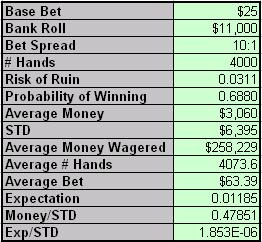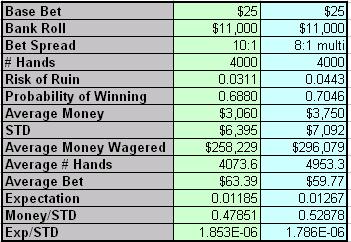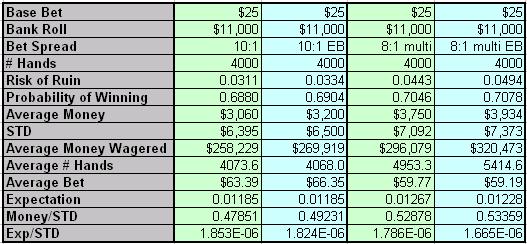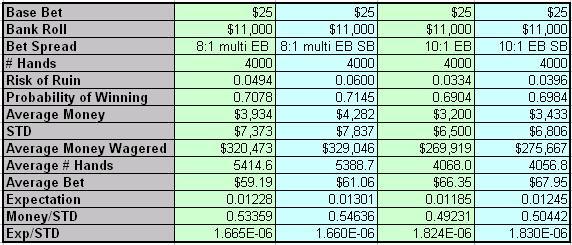Statistical Analysis
Statistical Analyses were conducted by simulating the BJ game for varying rule conditions and playing strategies. All simulations assumed heads-up play using exit strategy and error-free betting and counting. The affect of counting errors were investigated and resulted in higher variance but only small depreciation in expected outcome. Typical results look like the following:
- Base Bet is the lowest dollar amount we will wager at any given time. Typically this is the table minimum.
- Bank Roll is the amount of money will will bring with us on a trip.
- Bet Spread is the multiple spread between the minimum and maximum bet to be place (eg $25 to $250 is a 10:1 bet spread).
- # Hands is the expected number of hand for a specific trip. Typically we assume 100 hands per hour.
- Risk of Ruin is the probability that we will lose all the money in our Bank Roll.
- Probability of Winning is the probability that we will make more than $0.00.
- Average Money is the mean value of our expected profit for a given trip.
- STD is the standard deviation on the distribution of simulated outcomes.
- Average Money Wagered is the average of the total sum of money wagered during a given trip.
- Average # of Hands is the average number of hands played during a trip. This number is slightly higher than the simulated number of hands because splitting a hand becomes two hands.
- Average Bet is the average amount wagered on a given hand (ie Average Money Wagered / Average # of Hands).
- Expectation is the expected return on the money wagered (ie Average Money / Average Money Wagered).
- Money/STD is the average money earned over the standard deviation. This is a unit-less metric used to determine the relative effectiveness of a strategy change that maximizes return while minimizing variance.
- Exp/STD is the expectation over the standard deviation. Similar to Money/STD, this is a metric used to determine the relative effectiveness of a strategy change that maximizes return while minimizing variance.
10:1 versus 8:1 Multi Hand
In general, it is advantageous to use Kelly Betting to maximize return while minimizing risk-of-ruin. In reality, large bet variations will draw attention to you and eventually get you banned from the casino. As a result, Kelly Betting is capped off at an upper threshold with a bet spread of 8 to 1 or 10 to 1 (much above that tends to draw a lot of attention).
One innovation that we have incorporated into our strategy increased our overall expected return without significantly increasing the standard deviation, such that money earned / standard deviation is increased. For high counts, when there is player advantage, we play multiple hands and reduce our bet spread from 10:1 to 8:1 according to this bet specification. This allows us to effectively play more hands at high counts but also is less obvious to pit bosses since our bet spread has been reduced.
As shown in the results above, playing multiple hands at high counts increases the overall number of hands that we play as well as the total amount of money wagered. By playing more high count hands, the expectation increases from 1.19% to 1.27% and our average return for the trip increases by $700. The larger benefit of this approach is that we the standard deviation only increases slightly compared to the money earned as seen in the Money / STD metric. This effectively reduces the risk (uncertainty) of the outcome of a trip.
Early Betting
KnockOut BlackJack uses an uneven count in order to avoid having to continuously compute the true count based on the number of cards left in the shoe. As a result, it works the best in the middle of an average shoe and slightly worst at the beginning and ending of the shoe. Taking this into consideration, we use a concept we call Early Betting to take advantage of higher count values when only a couple decks have been played that traditional KnockOut BlackJack would discard. Advanced Bet Variation discussed how this betting strategy deviates from the single- and multi-hand approaches discussed above.
Since the relative player advantage when the count is between 14 and 17 (for IRC of 2) when less than 2 decks have been played is the same as the player advantage when the count is between 18 and 21 half way through the shoe, we can increase our earnings by taking advantage of early high counts. Even though our expectation is the same, the figure above shows that we are wagering more money on average and hence earning between $140 and $185 more for single hand and multi hand, respectively. The standard deviation does increase but we are still getting an increase in Money / STD.
Super Betting
Super betting is simply just an increase in bet spread. Instead of using a multi-hand bet spread of 8:1, we bet $250/hand (10 x base bet) for counts 30 and higher. For single-hand, the maximum bet increases to $300 (12 x base bet) for counts 30 and higher. Extreme caution needs to be used when applying this technique due to increased attention that you will receive.
Additional information on Super Betting can be found on the Discussion Board.



